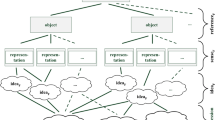Abstract
We consider the influence of a CAS context on a learner’s process of constructing a justification for the bifurcations in a logistic dynamical process. We describe how instrumentation led to cognitive constructions and how the roles of the learner and the CAS intertwine, especially close to the branching and combining of constructing actions. The CAS has a major influence on parallel constructions after branching and it facilitates combining. Hence, the CAS has the upper hand near branching points but the learner has the upper hand near combining points.






Similar content being viewed by others
Explore related subjects
Discover the latest articles, news and stories from top researchers in related subjects.References
Artigue, M. (2002). Learning mathematics in a CAS environment: The genesis of a reflection about instrumentation and the dialectics between technical and conceptual work. International Journal of Computers for Mathematical Learning, 7, 245–274.
Davydov, V. V. (1990). Soviet studies in mathematics education: Vol. 2. Types of generalization in instruction: Logical and psychological problems in the structuring of school curricula (J. Kilpatrick, Ed., & J. Teller, Trans.). Reston, VA: National Council of Teachers of Mathematics. (Original work published in 1972).
Dreyfus, T., Hershkowitz, R., & Schwarz, B. B. (2001). Abstraction in Context II: The case of peer interaction. Cognitive Science Quarterly, 1, 307–368.
Dreyfus, T., & Kidron, I. (2006). Interacting parallel constructions: A solitary learner and the bifurcation diagram. Recherches en didactique des mathématiques, 26, 295–336.
Guin, D., Ruthven, K., & Trouche, L. (2005). The didactical challenge of symbolic calculators: Turning a computational device into a mathematical instrument. (Introduction, pp. 1–8). New York: Springer.
Hershkowitz, R., Hadas, N., Dreyfus, T., & Schwarz, B. B. (2007). Processes of abstraction, from the diversity of individuals’ constructing of knowledge to a group’s “shared knowledge”. Mathematics Education Research Journal, 19, 41–68.
Hershkowitz, R., Schwarz, B. B., & Dreyfus, T. (2001). Abstraction in context: Epistemic actions. Journal for Research in Mathematics Education, 32, 195–222.
Hitt, F., & Kieran, C. (2009). Constructing knowledge via a peer interaction in a CAS environment with tasks designed from a task-technique-theory perspective. International Journal of Computers for Mathematical Learning, 14, 121–152.
Kidron, I., & Dreyfus, T. (2004). Constructing knowledge about the bifurcation diagram: Epistemic actions and parallel constructions. In M. J. Høines & A. B. Fuglestad (Eds.), Proceedings of the 28th annual conference of the international group for psychology of mathematics education, Vol. 3 (pp. 153–160). Bergen: Bergen University College.
Kidron, I., & Dreyfus, T. (2010). Justification enlightenment and combining constructions of knowledge. Educational Studies in Mathematics, 74(1), 75–93.
Noss, R., & Hoyles, C. (1996). Windows on mathematical meanings: Learning cultures and computers. Dordrecht: Kluwer.
Pontecorvo, C., & Girardet, H. (1993). Arguing and reasoning in understanding historical topics. Cognition and Instruction, 11, 365–395.
Schwarz, B. B., Dreyfus, T., & Hershkowitz, R. (2009). The nested epistemic actions model for abstraction in context. In B. B. Schwarz, T. Dreyfus, & R. Hershkowitz (Eds.), Transformation of knowledge through classroom interaction (pp. 11–41). London: Routledge.
Schwarz, B. B., & Hershkowitz, R. (1995). Argumentation and reasoning in a technology-based class. In J. F. Lehman & J. D. Moore (Eds.), Proceedings of the 17th annual meeting of the cognitive science society (pp. 731–735). Mahwah, NJ: Lawrence Erlbaum Associates.
Trouche, L. (2005). An instrumental approach to mathematics learning in symbolic calculators environments. In D. Guin, K. Ruthven, & L. Trouche (Eds.), The didactical challenge of symbolic calculators: Turning a computational device into a mathematical instrument (pp. 137–162). New York: Springer.
Vérillon, P., & Rabardel, P. (1995). Cognition and artifacts: A contribution to the study of thought in relation to instrumented activity. European Journal of Psychology of Education, 10, 77–101.
Acknowledgments
This research has been supported by the Israel Science Foundation under grant number 843/09.
Author information
Authors and Affiliations
Corresponding author
Rights and permissions
About this article
Cite this article
Kidron, I., Dreyfus, T. Interacting Parallel Constructions of Knowledge in a CAS Context. Int J Comput Math Learning 15, 129–149 (2010). https://doi.org/10.1007/s10758-010-9166-6
Published:
Issue Date:
DOI: https://doi.org/10.1007/s10758-010-9166-6



